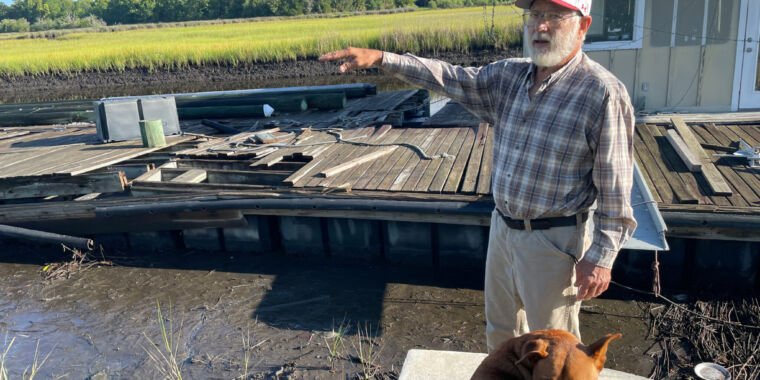In the South, sea level rise accelerates at some of the most extreme rates on Earth

This article originally appeared on Inside Climate News, a nonprofit, independent news organization that covers climate, energy, and the environment. It is republished with permission. Sign up for their newsletter here.
JACKSONVILLE, Fla.—For most of his life, Steve Salem has led an existence closely linked with the rise and fall of the tides.
Salem is a 50-year boat captain who designed and built his 65-foot vessel by hand.
“Me and Noah, we’re related somewhere,” said Salem, 75, whose silver beard evokes Ernest Hemingway.
Salem is familiar with how the sun and moon influence the tides and feels an innate sense for their ebb and flow, although the tides here are beginning to test even his intuition.
He and his wife live in a rust-colored ranch-style house along a tributary of the St. Johns River, Florida’s longest. Before they moved in the house had flooded, in 2017, as Hurricane Irma swirled by. The house flooded again in 2022, when Hurricane Nicole defied his expectations. But Salem believes the house is sturdy and that he can manage the tides, as he always has.
“I’m a water dog to begin with. I’ve always been on the water,” said Salem, who prefers to go by Captain Steve. “I worry about things that I have to do something about. If I can’t do anything about it, then worrying about it is going to do what?”
Across the American South, tides are rising at accelerating rates that are among the most extreme on Earth, constituting a surge that has startled scientists such as Jeff Chanton, professor in the Department of Earth, Ocean and Atmospheric Science at Florida State University.
“It’s pretty shocking,” he said. “You would think it would increase gradually, it would be a gradual thing. But this is like a major shift.”
Worldwide sea levels have climbed since 1900 by some 1.5 millimeters a year, a pace that is unprecedented in at least 3,000 years and generally attributable to melting ice sheets and glaciers and also the expansion of the oceans as their temperatures warm. Since the middle of the 20th century the rate has gained speed, exceeding 3 millimeters a year since 1992.
In the South the pace has quickened further, jumping from about 1.7 millimeters a year at the turn of the 20th century to at least 8.4 millimeters by 2021, according to a 2023 study published in Nature Communications based on tidal gauge records from throughout the region. In Pensacola, a beachy community on the western side of the Florida Panhandle, the rate soared to roughly 11 millimeters a year by the end of 2021.
“I think people just really have no idea what is coming, because we have no way of visualizing that through our own personal experiences, or that of the last 250 years,” said Randall Parkinson, a coastal geologist at Florida International University. “It’s not something where you go, ‘I know what that might look like because I’ve seen that.’ Because we haven’t.
“It’s the same everywhere, from North Carolina all the way down to the Florida Keys and all the way up into Alabama,” he said. “All of these areas are extremely vulnerable.”
The acceleration is poised to amplify impacts such as hurricane storm surges, nuisance flooding and land loss. In recent years the rising tides have coincided with record-breaking hurricane seasons, pushing storm surges higher and farther inland. In 2022 Hurricane Ian, which came ashore in southwest Florida, was the costliest hurricane in state history and third-costliest to date in the United States, after Katrina in 2005 and Harvey in 2017.
“It doesn’t even take a major storm event anymore. You just get these compounding effects,” said Rachel Cleetus, a policy director at the Union for Concerned Scientists, an advocacy group. “All of a sudden you have a much more impactful flooding event, and a lot of the infrastructure, frankly, like the stormwater infrastructure, it’s just not built for this.”
Source link




